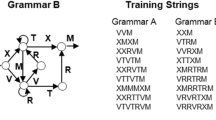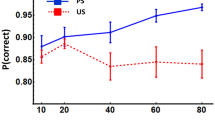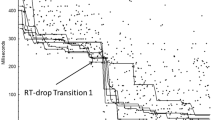Abstract
The ability to detect patterns and organize individual events into complex sequences is a fundamental cognitive skill that is often learned implicitly. The serial response time (SRT) task has been widely used to investigate implicit sequence learning, but it remains unclear whether people learn a perceptual or motor sequence in this task. This study reports three experiments that build on previous research by Goschke and colleagues using an auditory SRT task in which the stimulus-to-response mapping changes on every trial to eliminate spatio-motor sequencing. The current study extends earlier work in three ways. First, healthy young and older adults were tested rather than the neuropsychological patients used in previous research. Second, sequences of different structural complexity were investigated including first- and second-order repeating sequences as well as higher-order probabilistic sequences. Third, the potential role of explicit knowledge was examined using three separate tests of declarative knowledge. Results indicate that young and old adults are able to learn purely perceptual auditory sequences, but that explicit knowledge contributes to learning of repeating sequences by young adults.








Similar content being viewed by others
Notes
The first six participants in each group received a foil sequence that was completely random. This sequence potentially contained repetitions of a stimulus, an event which never occurred in the training sequence and may have been a salient cue to the categorization of the sequence. Participants #7–12 in each group received a foil consistent with that described in the paper. Their data alone were used in recognition analyses.
One older and one younger participant were excluded from the Production analysis for failure to follow task instructions. During the exclusion block the older adult repeatedly hit the same key, where the younger adult reported that she continued to respond as they were during the inclusion block.
References
Braver TS, Barch DM, Keys BA, Carter CS, Cohen JD, Kaye JA, Janowsky JS, Taylor SF, Yesavage JA, Mumenthaler MS, Jagust WJ, Reed BR (2001) Context processing in older adults: evidence for a theory relating cognitive control to neurobiology in healthy aging. J Exp Psychol Gen 130:746–763
Curran T (1997) Effects of aging on implicit sequence learning: accounting for sequence structure and explicit knowledge. Psychol Res 60:24–41
Dennis NA, Howard JH Jr, Howard DV (2003a) Age deficits in learning sequences of spoken words. J Gerontol B Psychol Sci Soc Sci 58:224–227
Dennis NA, Howard JH Jr, Howard DV, Coyle M, Lynch B, Bradley N (2003b) Implicit higher-order sequence learning by event observation. In: 74th Annual Eastern Psychological Association Conference, Baltimore, MD
Destrebecqz A, Cleeremans A (2001) Can sequence learning be implicit? New evidence with the process dissociation procedure. Psychon Bull Rev 8:343–350
Frensch PA, Miner CS (1994) Effects of presentation rate and individual differences in short-term memory capacity on an indirect measure of serial learning. Mem Cognit 22:95–110
Frensch PA, Lin J, Buchner A (1998) Learning versus behavioral expression of the learned: The effects of a secondary tone-counting task on implicit learning in the serial reaction task. Psychol Res 61:83–98
Garofolo JS, Lamel LF, Fisher WM, Fiscus JG, Pallet DS, Dahlgren NL (1993) The DARPA TIMIT acoustic-phonetic continuous speech corpus CDROM, vol January 2000 http://www.ldc.upenn.edu/Catalog/docs/TIMIT.html
Goschke T, Friederici AD, Kotz SA, van Kampen A (2001) Procedural learning in Broca’s aphasia: dissociation between the implicit acquisition of spatio-motor and phoneme sequences. J Cogn Neurosci 13:370–388
Grafton ST, Hazeltine E, Ivry I (1995) Functional mapping of sequence learning in normal humans. J Cogn Neurosci 7:497–510
Grafton ST, Fagg AH, Arbib MA (1998a) Dorsal premotor cortex and conditional movement selection: A PET functional mapping study. J Neurophysiol 79:1092–1097
Grafton ST, Hazeltine E, Ivry RB (1998b) Abstract and effector-specific representations of motor sequences identified with PET. J Neurosci 18:9420–9428
Grafton ST, Hazeltine E, Ivry RB (2002) Motor sequence learning with the nondominant left hand. A PET functional imaging study. Exp Brain Res 146:369–378
Hazeltine E, Grafton ST, Ivry R (1997) Attention and stimulus characteristics determine the locus of motor—sequence encoding. A PET study. Brain 120:123–140
Heyes CM, Foster CL (2002) Motor learning by observation: evidence from a serial reaction time task. Q J Exp Psychol A 55:593–607
Howard DV, Howard JH Jr (1989) Age differences in learning serial patterns: direct versus indirect measures. Psychol Aging 4:357–364
Howard DV, Howard JH Jr (1992) Adult age differences in the rate of learning serial patterns: evidence from direct and indirect tests. Psychol Aging 7:232–241
Howard JH Jr, Howard DV (1997) Age differences in implicit learning of higher order dependencies in serial patterns. Psychol Aging 12:634–656
Howard JH Jr, Mutter SA, Howard DV (1992) Serial pattern learning by event observation. J Exp Psychol Learn Mem Cogn 18:1029–1039
Howard DV, Howard JH Jr, Japikse K, DiYanni C, Thompson A, Somberg R (2004) Implicit sequence learning: effects of level of structure, adult age, and extended practice. Psychol Aging 19:79–92
Howard JH Jr, Howard DV, Dennis NA, Yankovich H, Vaidya CJ (2004) Implicit spatial contextual learning in healthy aging. Neuropsychology 18:124–134
Japikse KC, Negash S, Howard JH Jr, Howard DV (2003) Intermanual transfer of procedural learning after extended practice of probabilistic sequences. Exp Brain Res 148:38–49
Lungu OV, Wachter T, Liu T, Willingham DT, Ashe J (2004) Probability detection mechanisms and motor learning. Exp Brain Res 159:135–150
Mayr U (1996) Spatial attention and implicit sequence learning: evidence for independent learning of spatial and nonspatial sequences. J Exp Psychol Learn Mem Cogn 22:350–364
Negash S, Howard DV, Japiske KC, Howard JH Jr (2003) Age-related differences in implicit learning of non-spatial sequential patterns. Aging Neuropsychol Cogn 10:108–121
Nissen MJ, Bullemer P (1987) Attentional requirements of learning: evidence from performance measures. Cogn Psychol 19:1–32
Pascual-Leone A, Wassermann EM, Grafman J, Hallett M (1996) The role of the dorsolateral prefrontal cortex in implicit procedural learning. Exp Brain Res 107:479–485
Reber AS (1993) Implicit learning and tacit knowledge: an essay on the cognitive unconscious. Oxford University Press, New York, NY, USA
Remillard G, Clark JM (2001) Implicit learning of first-, second-, and third-order transition probabilities. J Exp Psychol Learn Mem Cogn 27:483–498
Robertson EM, Pascual-Leone A (2001) Aspects of sensory guidance in sequence learning. Exp Brain Res 137:336–345
Russeler J, Rosler F (2000) Implicit and explicit learning of event sequences: evidence for distinct coding of perceptual and motor representations. Acta Psychol (Amst) 104:45–67
Salthouse TA (1996) The processing-speed theory of adult age differences in cognition. Psychol Rev 103:403–428
Salthouse TA, McGurthy KA, Hambrick DZ (1999) A framework for analyzing and interpreting differential aging patterns: application to three measures of implicit learning. Aging Neuropsychol Cogn 6:1–18
Seidler RD, Purushotham A, Kim SG, Ugurbil K, Willingham D, Ashe J (2005) Neural correlates of encoding and expression in implicit sequence learning. Exp Brain Res 165:114–124
Willingham DB (1999) Implicit motor sequence learning is not purely perceptual. Mem Cognit 27:561–572
Willingham DB, Greenberg AR, Thomas RC (1997) Response-to-stimulus interval does not affect implicit motor sequence learning, but does affect performance. Mem Cognit 25:534–542
Willingham DB, Nissen MJ, Bullemer P (1989) On the development of procedural knowledge. J Exp Psychol Learn Mem Cogn 15:1047–1060
Ziessler M (1994) The impact of motor responses on serial-pattern learning. Psychol Res 57:30–41
Ziessler M, Nattkemper D (2001) Learning of event sequences is based on response-effect learning: further evidence from a serial reaction task. J Exp Psychol Learn Mem Cogn 27:595–613
Acknowledgment
This work was supported by NIA Grant R37 AG15450 and completed in partial fulfillment of the requirements for NAD’s PhD at the Catholic University of America. Partial support was provided by NIA grant T32 AG00029 (NAD). Preliminary results were reported at the 2002 Society for Neuroscience Conference in Orlando, FL and 2003 Cognitive Neuroscience Society Meeting in New York City, NY. We thank Raja Parasuraman and Pam Greenwood for their comments and suggestions on previous versions of this manuscript. We also thank the many RAs who helped with data collection, Kate LaVine, Nicole Bradley, Bridget Lynch, Andrew Kelly, Sean LaVine, and Alisa Padon.
Author information
Authors and Affiliations
Corresponding author
Rights and permissions
About this article
Cite this article
Dennis, N.A., Howard, J.H. & Howard, D.V. Implicit sequence learning without motor sequencing in young and old adults. Exp Brain Res 175, 153–164 (2006). https://doi.org/10.1007/s00221-006-0534-3
Received:
Accepted:
Published:
Issue Date:
DOI: https://doi.org/10.1007/s00221-006-0534-3




